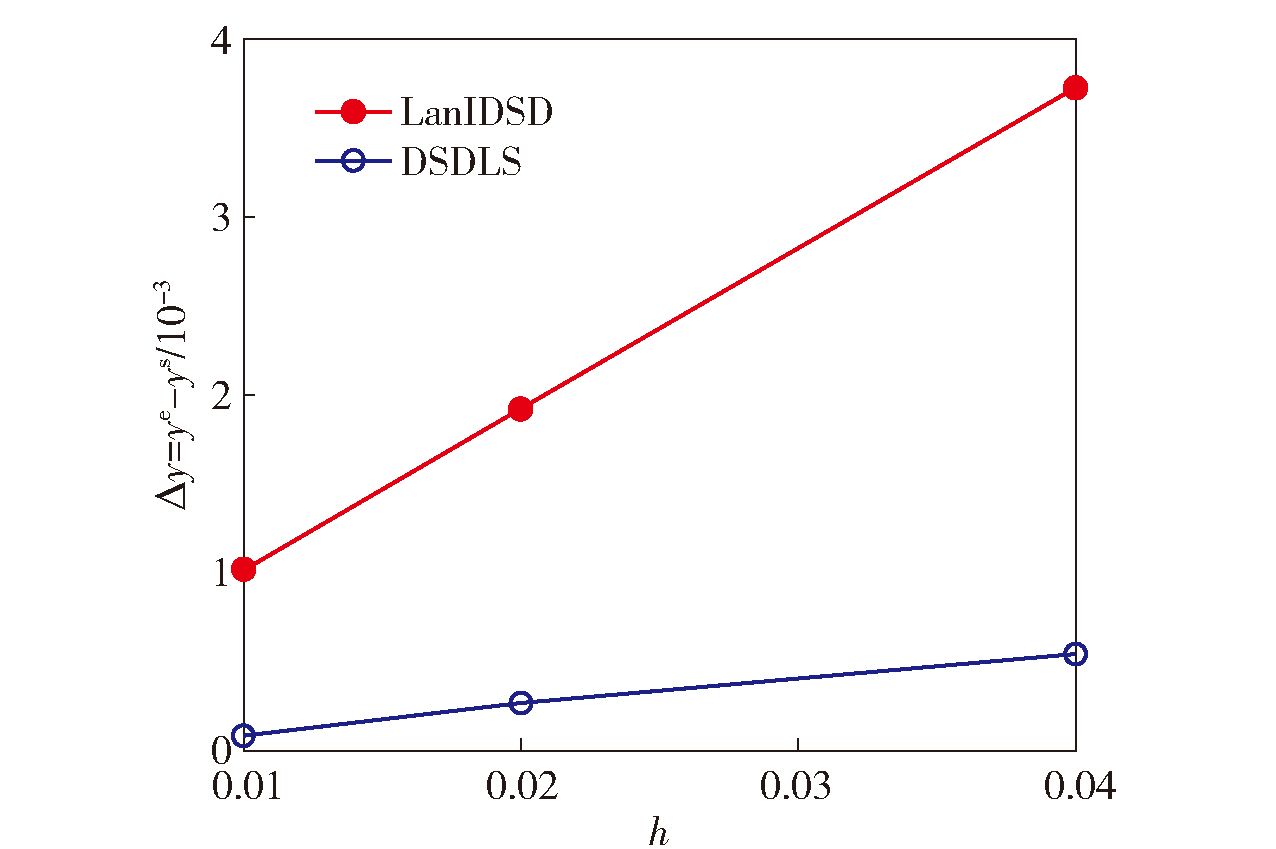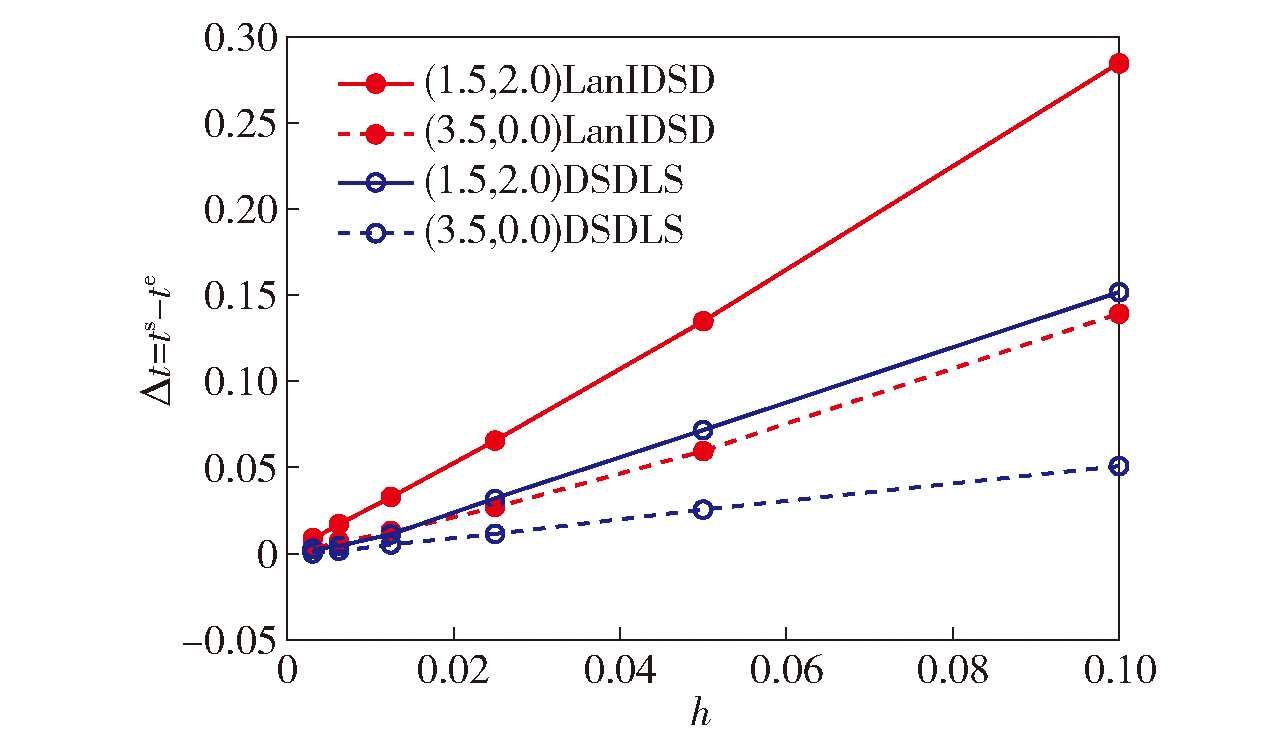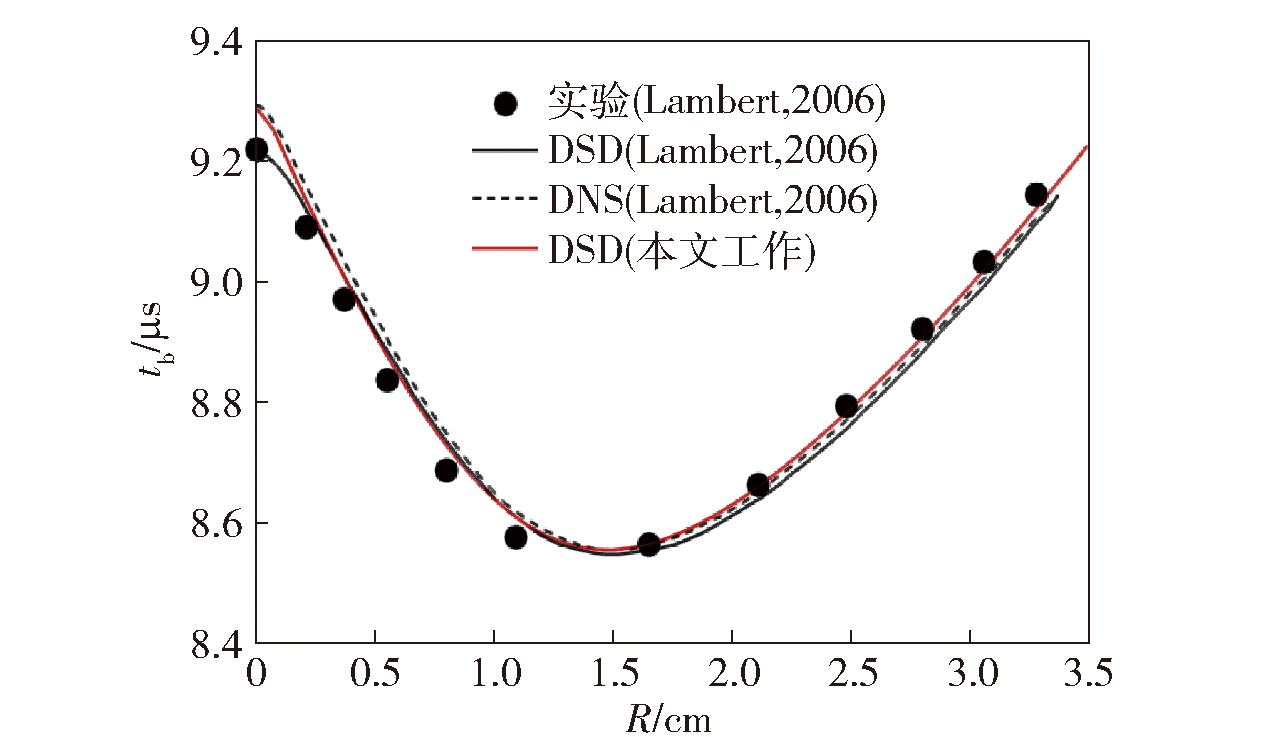


主管单位:中国科学技术协会
主办单位:中国兵工学会
ISSN 1000-1093 CN 11-2176/TJ
主办单位:中国兵工学会
ISSN 1000-1093 CN 11-2176/TJ



兵工学报 ›› 2025, Vol. 46 ›› Issue (10): 250411-.doi: 10.12382/bgxb.2025.0411
收稿日期:2025-05-27
上线日期:2025-11-05
通讯作者:
基金资助:
XIONG Jun*, DAI Yijun**( ), GONG Xiangfei, LIU Lufeng
), GONG Xiangfei, LIU Lufeng
Received:2025-05-27
Online:2025-11-05
摘要:
在均匀二维/三维笛卡尔网格上,数值离散和求解基于爆轰冲击波动力学(Detonation Shock Dynamics, DSD)理论的level set方程,得到的炸药稳定传播爆轰波阵面到达时刻,可用于流体动力学数值模拟的程序燃烧算法。简化和改进了DSD边界条件算法,包括边界节点模板选取方法,及边界节点排序方法。研制了消息传递接口与共享存储多线程混合并行程序DSDLS,可高效求解大规模爆轰问题。利用一系列解析解、半解析解,以及爆轰实验,对算法及程序进行了验证与确认。数值模拟得到的爆轰波走时结果与精确解、实验数据相符。超10亿节点网格大规模并行测试表明,DSDLS程序具有良好的并行效率及可扩展性。
熊俊, 代仪军, 宫翔飞, 刘鲁峰. 一种改进的高效并行爆轰冲击波动力学算法及验证与确认[J]. 兵工学报, 2025, 46(10): 250411-.
XIONG Jun, DAI Yijun, GONG Xiangfei, LIU Lufeng. An Improved Efficient Parallel DSD Algorithm and Its Verification & Validation[J]. Acta Armamentarii, 2025, 46(10): 250411-.
| 单元尺寸h | 误差E1 | 收敛阶 |
|---|---|---|
| 1/40 | 5.5335×10-4 | - |
| 1/80 | 1.0581×10-4 | 2.38 |
| 1/160 | 2.8199×10-5 | 1.90 |
| 1/320 | 6.9404×10-6 | 2.02 |
表1 外爆球形爆轰波问题的网格收敛率
Table 1 Grid convergence rate for the expanding sphere detonation problem
| 单元尺寸h | 误差E1 | 收敛阶 |
|---|---|---|
| 1/40 | 5.5335×10-4 | - |
| 1/80 | 1.0581×10-4 | 2.38 |
| 1/160 | 2.8199×10-5 | 1.90 |
| 1/320 | 6.9404×10-6 | 2.02 |
| 点编号 | x | ye=f(x,t) |
|---|---|---|
| 1 | 0.00 | 5.902965 |
| 2 | 0.52 | 5.858715 |
| 3 | 0.96 | 5.696289 |
表2 炸药柱爆轰波问题的参考解
Table 2 The reference solutions for the rate stick detonation problem
| 点编号 | x | ye=f(x,t) |
|---|---|---|
| 1 | 0.00 | 5.902965 |
| 2 | 0.52 | 5.858715 |
| 3 | 0.96 | 5.696289 |

图11 炸药柱爆轰波问题:x=0处纵坐标计算误差收敛情况对比
Fig.11 Resolution study for the rate stick detonation problem: error in y location with respect to the reference lution at x=0 and burntime=5.0

图14 典型位置处爆轰波到达时刻计算误差随网格单元尺寸的变化
Fig.14 Error in burn arrival times with respect to the “exact” solutions, recorded at (3.5, 0.0) and (1.5, 2.0) with varying DSD grid spacing
| 材料 | 参数 | 数值 |
|---|---|---|
| PBX 9501 | DCJ/(km·s-1) | 8.86 |
| α0/cm | 0.04 | |
| PBX 9501/铅 | ωc | 66° |
| ωs | 35° |
表3 Passover实验PBX 9501炸药和铅的材料参数
Table 3 The material parameters of PBX 9501 and lead for the DSD simulation of passover experiment
| 材料 | 参数 | 数值 |
|---|---|---|
| PBX 9501 | DCJ/(km·s-1) | 8.86 |
| α0/cm | 0.04 | |
| PBX 9501/铅 | ωc | 66° |
| ωs | 35° |

图17 Passover实验、DSD计算得到的爆轰波到达炸药柱上表面的时间与实验数据及文献提供的DSD、DNS计算结果的对比
Fig.17 Time of arrival at the top surface of the device for the passover experiment, comparison of experiments, DNS and DSD simulations
| 材料 | 参数 | 数值 |
|---|---|---|
| PBX 9501 | DCJ/(km·s-1) | 8.81 |
| α0/cm | 0.04 | |
| PBX 9502 | DCJ/(km·s-1) | 7.80 |
| α0/cm | 0.08 | |
| PBX 9502/钢 | ωc | 65° |
| ωs | 58° | |
| PBX 9502/锡 | ωc | 62° |
| ωs | 58° |
表4 Cyclops实验DSD模型相关材料参数
Table 4 The material parameters for the DSD simulation of Cyclops experiment
| 材料 | 参数 | 数值 |
|---|---|---|
| PBX 9501 | DCJ/(km·s-1) | 8.81 |
| α0/cm | 0.04 | |
| PBX 9502 | DCJ/(km·s-1) | 7.80 |
| α0/cm | 0.08 | |
| PBX 9502/钢 | ωc | 65° |
| ωs | 58° | |
| PBX 9502/锡 | ωc | 62° |
| ωs | 58° |

图19 Cyclops实验,DSD计算得到的爆轰波阵面到达时刻等值线及与实验数据的对比
Fig.19 Contours of detonation front TOA for the Cyclops experiment compared to the detonation isochrone position data
| 进程数 | 墙钟时间/s | 并行效率/% |
|---|---|---|
| 16 | 55092 | - |
| 32 | 29556 | 93.2 |
| 64 | 15362 | 89.7 |
| 128 | 7942 | 86.7 |
| 256 | 4216 | 81.7 |
| 512 | 2205 | 78.1 |
| 1024 | 1172 | 73.4 |
| 2048 | 668 | 64.4 |
| 4096 | 386 | 55.8 |
| 8192 | 248 | 43.4 |
表5 MPI并行效率测试
Table 5 Test of MPI parallel efficiency
| 进程数 | 墙钟时间/s | 并行效率/% |
|---|---|---|
| 16 | 55092 | - |
| 32 | 29556 | 93.2 |
| 64 | 15362 | 89.7 |
| 128 | 7942 | 86.7 |
| 256 | 4216 | 81.7 |
| 512 | 2205 | 78.1 |
| 1024 | 1172 | 73.4 |
| 2048 | 668 | 64.4 |
| 4096 | 386 | 55.8 |
| 8192 | 248 | 43.4 |
| 算例编号 | 进程数 | 线程数 | 墙钟时间/s |
|---|---|---|---|
| 1 | 32 | 1* | 805 |
| 2 | 32 | 1 | 825 |
| 3 | 32 | 2 | 560 |
| 4 | 64 | 1 | 482 |
| 5 | 64 | 2 | 354 |
表6 MPI+OpenMP混合并行效率测试
Table 6 Efficiency test of hybrid MPI and OpenMP parallel programming
| 算例编号 | 进程数 | 线程数 | 墙钟时间/s |
|---|---|---|---|
| 1 | 32 | 1* | 805 |
| 2 | 32 | 1 | 825 |
| 3 | 32 | 2 | 560 |
| 4 | 64 | 1 | 482 |
| 5 | 64 | 2 | 354 |
| [1] |
|
| [2] |
|
| [3] |
|
| [4] |
|
| [5] |
|
| [6] |
|
| [7] |
张旭. 曲线坐标系中钝感炸药非理想爆轰波传播的Level Set 方法[D]. 绵阳: 中国工程物理研究院, 1999.
|
|
|
|
| [8] |
柏劲松, 李平, 钟敏, 等. 以DSD理论和LS方法为基础的程序燃烧法[J]. 爆炸与冲击, 2008, 28(5): 401-406.
|
|
|
|
| [9] |
姜洋, 钟敏, 孙承纬, 等. 非理想爆轰波阵面传播的Level Set方法应用研究[J]. 兵工学报, 2010, 31(7): 896-901.
|
|
|
|
| [10] |
钟敏. 三维非理想爆轰波阵面传播过程的数值方法和数值模拟[D]. 中国工程物理研究院, 2005.
|
|
|
|
| [11] |
张莉, 吴开腾. 固定界面Level Set方法在爆轰波阵面传播中的应用[J]. 兵工学报, 2019, 40(10): 2080-2087.
|
|
|
|
| [12] |
谭多望, 方青, 张光升, 等. 常温下JB-9014钝感炸药的DSD参数研究[J]. 高压物理学报, 2009, 23(3): 161-166.
|
|
|
|
| [13] |
姜洋, 黎源, 唐蜜, 等. 惰性介质约束下非理想爆轰波的传播[J]. 高压物理学报, 2013, 27(4): 599-603.
|
|
|
|
| [14] |
|
| [15] |
|
| [16] |
|
| [17] |
|
| [18] |
|
| [19] |
|
| [20] |
|
| [21] |
|
| [22] |
|
| [23] |
陈江涛, 肖维, 赵炜, 等. 计算流体力学验证与确认研究进展[J]. 力学进展, 2023, 53(3): 626-660.
|
|
|
|
| [24] |
|
| [25] |
|
| [26] |
|
| [27] |
|
| [28] |
|
| [29] |
|
| [30] |
|
| [1] | 刘启明, 樊铮炎, 李涛, 杨伟龙, 韩旭. 高过载环境下弹载电子封装焊点失效机理[J]. 兵工学报, 2025, 46(9): 241006-. |
| [2] | 顾敏辉, 唐奎, 王金相, 夏靖雯, 李渊博, 王鸿飞. 带切缝PELE的侵彻破碎特性及毁伤后效[J]. 兵工学报, 2025, 46(8): 240898-. |
| [3] | 安骋远, 刘海鹏, 刘彦, 任炜. 椭圆截面柱形炸药爆炸冲击波威力特性[J]. 兵工学报, 2025, 46(8): 240969-. |
| [4] | 李青松, 王磊, 赵宁, 张笑天, 张磊, 王克鸿. 电弧增材框体结构有限元仿真模拟与实验[J]. 兵工学报, 2025, 46(7): 240629-. |
| [5] | 闫铭, 王昕捷, 黄风雷, 尤飒. 高超声速气动加热下战斗部装药热-点火响应与典型结构热防护特性[J]. 兵工学报, 2025, 46(6): 240401-. |
| [6] | 刘曦, 马天宝, 李健. 气相爆轰波温度界面折射问题的数值模拟[J]. 兵工学报, 2025, 46(10): 250377-. |
| [7] | 李元, 王天池, 侯兵, 索涛, 豆清波. 烧结纤维网络材料爆炸冲击防护数值模拟[J]. 兵工学报, 2025, 46(10): 250402-. |
| [8] | 易晓菲, 彭克锋, 常白雪, 张元瑞, 刘家贵, 郑志军. 仿爆炸加载下仿生梯度双波纹结构的动态响应[J]. 兵工学报, 2025, 46(10): 250344-. |
| [9] | 朱炜, 姚文进, 黄广炎, 李文彬, 王晓鸣. 纳米多孔材料液体系统对近场爆炸载荷削弱效应[J]. 兵工学报, 2025, 46(10): 250468-. |
| [10] | 贾迪, 陈传庆, 李鑫. 泡沫基负有效质量超材料抗爆性能的数值模拟[J]. 兵工学报, 2025, 46(10): 250505-. |
| [11] | 刘贞娴, 蒋建伟, 李梅, 谢泓炜. 压环对爆炸成型弹丸成型影响的高精度仿真分析[J]. 兵工学报, 2025, 46(1): 231193-. |
| [12] | 杨茜, 冯榆坤, 陈作钢, 张岩. 浅水条件下喷水推进船航态及喷射流形态研究[J]. 兵工学报, 2024, 45(S2): 123-132. |
| [13] | 姜豪杰, 彭永, 孙宇雁, 王子国, 徐佳沛. RC桥墩的爆炸毁伤规律及快速计算模型[J]. 兵工学报, 2024, 45(S2): 305-316. |
| [14] | 许辉, 陈作钢, 蔡佑林. 基于壁模化大涡数值模拟的喷水推进泵内湍流运动特性分析[J]. 兵工学报, 2024, 45(S2): 55-64. |
| [15] | 金文, 蒋建伟, 门建兵, 李梅, 李海峰, 周鑫. 柱形容器约束下内装粉体冲击响应特性[J]. 兵工学报, 2024, 45(S1): 183-190. |
| 阅读次数 | ||||||
|
全文 |
|
|||||
|
摘要 |
|
|||||
 京公网安备11010802024360号 京ICP备05059581号-4
京公网安备11010802024360号 京ICP备05059581号-4